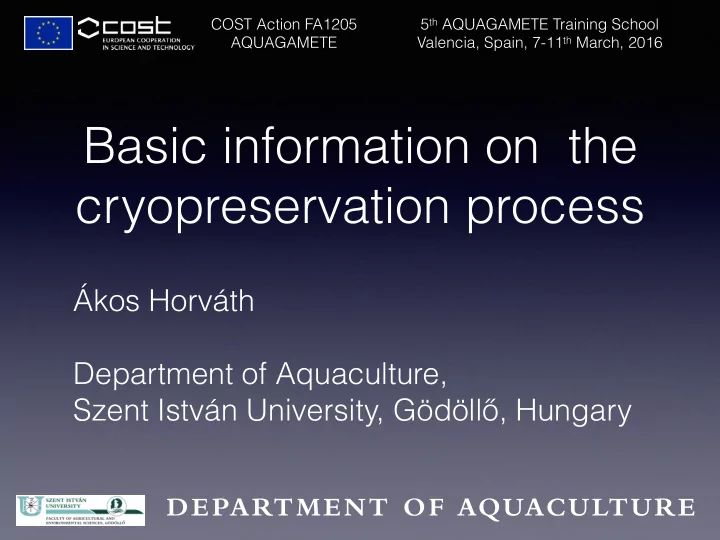

COST Action FA1205 5 th AQUAGAMETE Training School AQUAGAMETE Valencia, Spain, 7-11 th March, 2016 Basic information on the cryopreservation process Ákos Horváth Department of Aquaculture, Szent István University, Gödöll ő , Hungary DEPARTMENT OF AQUACULTURE
Summary • Cryopreservation: basics of cryopreservation – cooling of water and aqueous solutions • Cryopreservation: cooling of live cells, vitrification, the role of cryoprotectants • Cryopreservation of fish sperm – the role of extenders, cryoprotectants and dilution ratios • Cryopreservation of fish sperm – methods, straws, cooling rates • Cryopreservation of fish sperm – storage, thawing • Cryopreservation of fish sperm – fertilization with cryopreserved sperm • Commercial application – reasons of failure DEPARTMENT OF AQUACULTURE
Cryopreservation: basics of cryopreservation – cooling of water and aqueous solutions DEPARTMENT OF AQUACULTURE
Cryopreservation: basics of cryopreservation – cooling of water and aqueous solutions 40 0 • Water supercools below the Temperature (°C) freezing point -40 • Ice formation starts along ice -80 nuclei -120 • Primarily water molecules are incorporated into the ice -160 crystals 0 20 40 60 80 100 120 140 160 180 200 220 240 Time (seconds) Distilled water Extender + cryoprotectant DEPARTMENT OF AQUACULTURE
Cryopreservation: cooling of live cells, vitrification, the role of cryoprotectants H 2 O Slow cooling Thawing Case 1. H 2 O H 2 O Fast cooling Thawing Case 2. H 2 O Optimum cooling Thawing Case 3. H 2 O Ultra-fast cooling Thawing Case 4. DEPARTMENT OF AQUACULTURE
Cryopreservation: cooling of live cells, vitrification, the role of cryoprotectants – Roles • Cryoprotectants – External cryoprotectants • Membrane stabilization • Sugars (glucose, fructose, sucrose, trehalose) • Inhibition of ice • Polymers (polyvinyl pyrrolidone) crystallization – Internal cryoprotectants • Lowering of the • Alcohols – methanol freezing point • Polyols – ethylene glycol, propylene glycol, glycerol • Others: dimethyl sulfoxide (DMSO), dimethyl acetamide (DMA) DEPARTMENT OF AQUACULTURE
Cryopreservation of fish sperm – the role of extenders, cryoprotectants and dilution ratios • Estimation of motility – Visual – CASA • Extenders – solution of sugars and salts • Cryoprotectants – most often DMSO or methanol • Dilution ratios: from 1:1 to 1:9 DEPARTMENT OF AQUACULTURE
Cryopreservation of fish sperm – methods, straws, cooling rates • Cooling in pellets: – In a block of dry ice – Requires a thawing medium • Cooling in straws: – Most common technique – Used in most livestock species • Cryovials • Glass capillaries DEPARTMENT OF AQUACULTURE
Cryopreservation of fish sperm – methods, straws, cooling rates • Cooling in the vapor of liquid nitrogen – Styrofoam box • Simplicity • Low cost – Computer-controlled freezer • Controlled conditions • More reliable replication DEPARTMENT OF AQUACULTURE
Cryopreservation of fish sperm – methods, straws, cooling rates 45 0 Temperature (°C) -45 5 ml straws 1.2 ml staws 0.5 ml straws -90 -135 -180 0 60 120 180 240 300 Time (sec) DEPARTMENT OF AQUACULTURE
Cryopreservation of fish sperm – storage, thawing • Storage – Dewars: • Large capacity • Extended storage time • Shipping dewars – Other storage devices • Goblets • Canes • Thawing – Typically at 40°C DEPARTMENT OF AQUACULTURE
Cryopreservation of fish sperm – fertilization with cryopreserved sperm • Determination of post-thaw motility – varies with species • General rules of fertilization are similar to those with fresh sperm • Effective sperm:egg ratios start from 5000 spermatozoa to 1 egg • Research for the prediction of sperm quality without fertilization DEPARTMENT OF AQUACULTURE
Cryopreservation of fish sperm – fertilization with cryopreserved sperm 40 30 Hatch (%) 20 37 32 31 21 10 6 0 2 days 1 day 2 hours no storage control Storage time before fertilization DEPARTMENT OF AQUACULTURE
Prediction of sperm quality without fertilization 100 90 80 Post-thaw motility (%) 100 70 60 50 75 40 Fertilization (%) 30 20 50 10 0 5% MeOH 10% MeOH 15% MeOH 5% DMSO 10% DMSO 15% DMSO control 25 0 Motility is not always a good 5% MeOH 10% MeOH 15% MeOH 5% DMSO 10% DMSO 15% DMSO control predictor of fertilizing capacity DEPARTMENT OF AQUACULTURE
Prediction of sperm quality without fertilization Comet-assay: single-cell gel electrophoresis assay Viability: live-dead fluoresecent dual staining combined with flow Computer-assisted sperm analysis - cytometry CASA DEPARTMENT OF AQUACULTURE
Genetic damage associated with cryopreservation DEPARTMENT OF AQUACULTURE
Cryopreservation of fish eggs and embryos • Problems: – Egg envelope – Egg activation upon release into a liquid – Structure of fish embryos – Which embryonic stage to use • Limited success – Vitrification of flounder embryos – Vitrification of carp embryos DEPARTMENT OF AQUACULTURE
Cryopreservation in other aquatic species • Cryopreservation of bivalvian sperm • Differences from fish sperm: – Reduced post-thaw motility – Reduced fertilization – Extender osmolality around 1000 mOsmol/ kg DEPARTMENT OF AQUACULTURE
Cryopreservation in other aquatic species • Cryopreservation of larvae is possible • Best larval stages for cryopreservation are trochophores and veligers • Very slow cooling rates DEPARTMENT OF AQUACULTURE
Commercial application – reasons of failure • Very few cases of commercial application (if any) • Mostly sperm banks maintained by laboratories and research institutions • Reasons: – Science ahead of industry – Adaptation of protocols originally developed for livestock are not suitable for aquaculture – Low level of standardization and international cooperation DEPARTMENT OF AQUACULTURE
Further development Okutsu et al. 2007 Science, 317, 1517. • Cryopreservation and transplantation of primordial germ cells (PGCs) • Cryopreservation and transplantation of undi ff erentiated type A spermatogonia DEPARTMENT OF AQUACULTURE
Recommend
More recommend